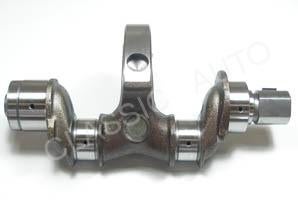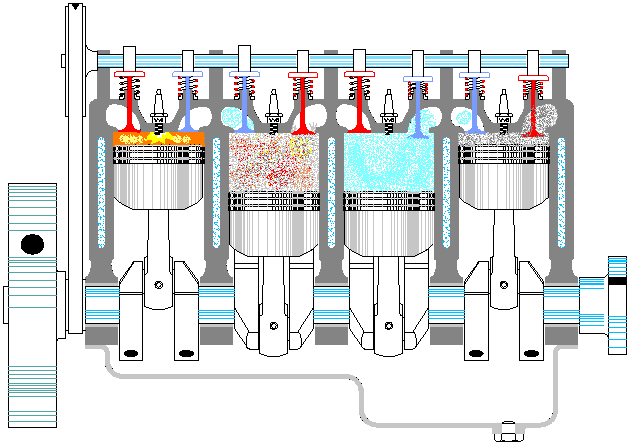 by "RallyDarkstrike - Fan of 2-cyl FIATs, Eastern Bloc & Kei cars" (rallydarkstrike)
by "RallyDarkstrike - Fan of 2-cyl FIATs, Eastern Bloc & Kei cars" (rallydarkstrike)
Published 12/30/2017 at 22:50
 by "RallyDarkstrike - Fan of 2-cyl FIATs, Eastern Bloc & Kei cars" (rallydarkstrike)
by "RallyDarkstrike - Fan of 2-cyl FIATs, Eastern Bloc & Kei cars" (rallydarkstrike)
Published 12/30/2017 at 22:50
Tags: FIAT 126
; FIAT 500
; Engines
STARS: 2
So, last evening and this evening Iíve been spending my free time watching this two-part series on how to reassemble a classic FIAT 500/FIAT 126 engine (yes, I am obsessed enough that Iím watching 2 hours of video on reassembling the engine for a car I donít even have yet :P):
!!! UNKNOWN CONTENT TYPE !!!
I didnít clue in until now, but I noticed something as he installed the pistons - the crankshaft - the pistons donít move in opposite, but move together with a counterweight opposite!

This boggled my mind! Now, I know how engines work, but I donít know a lot about the
design
side of engines....is this a common design for small, inline two-cylinder engines? I always thought one would fire and then be travelling down as the other was travelling up to itís firing point, this way they would be balancing each other out without needing a counterweight (and as it is an even number of pistons, it would run smoothly...right?)? The way the 500/126 engine is designed, both pistons are travelling together even though one is on itís firing stroke and the other is on itís exhaust stroke...very odd to me!
Anyone else find this an odd and interesting engineering choice? The more I research and learn about these little cars, the more enamored I become! :)
 "BaconSandwich is tasty." (baconsandwich)
"BaconSandwich is tasty." (baconsandwich)
12/30/2017 at 22:39, STARS: 1
That does seem interesting. Iíd be curious to hear why it is done that way.
 "Clown Shoe Pilot" (csp)
"Clown Shoe Pilot" (csp)
12/30/2017 at 23:14, STARS: 0
The way itís built, you get a power stroke every 360į of crank rotation. If the conrod journals were offset itíd run lumpy as hell.
 "RallyDarkstrike - Fan of 2-cyl FIATs, Eastern Bloc & Kei cars" (rallydarkstrike)
"RallyDarkstrike - Fan of 2-cyl FIATs, Eastern Bloc & Kei cars" (rallydarkstrike)
12/30/2017 at 23:21, STARS: 0
But arenít 2-cylinder bike engines of a similar size (650cc) offset and they run OK? (Though I know not a lot of them are directly inline).
 "bob and john" (bobandjohn)
"bob and john" (bobandjohn)
12/30/2017 at 23:25, STARS: 1
Smoother power. One cylinder fires each time it goes down
 "Clown Shoe Pilot" (csp)
"Clown Shoe Pilot" (csp)
12/30/2017 at 23:26, STARS: 0
Hmmm... indeed. I never took my cb500f engine apart but I looked it up and indeed the conrods are 180į apart.
So... yeah. I have no idea.
 "Aremmes" (aremmes)
"Aremmes" (aremmes)
12/30/2017 at 23:28, STARS: 4
Itís done that way to phase the power pulses evenly at 360į. Theoretically one could swing one of the throws around 180į and make the corresponding cylinder fire immediately after the other one, resulting in avery long pulse that lasts roughly 360į, but that leaves an equally long duration without any power. That would require a larger flywheel to dampen the pulses and store enough energy for the compression strokes, which would in turn make the engine less responsive to throttle inputs.
 "RallyDarkstrike - Fan of 2-cyl FIATs, Eastern Bloc & Kei cars" (rallydarkstrike)
"RallyDarkstrike - Fan of 2-cyl FIATs, Eastern Bloc & Kei cars" (rallydarkstrike)
12/30/2017 at 23:33, STARS: 0
Haha! Exactly! :P When I thought about it, I couldnít think of a super strong reason either!
I mean, if they were offset, they would be theoretically pretty much perfectly balanced as each piston/conrod would weigh the same, right?
 "RallyDarkstrike - Fan of 2-cyl FIATs, Eastern Bloc & Kei cars" (rallydarkstrike)
"RallyDarkstrike - Fan of 2-cyl FIATs, Eastern Bloc & Kei cars" (rallydarkstrike)
12/30/2017 at 23:36, STARS: 0
Thank you! Excellent explanation! :D
DO bike engines, in fact work this way as well? I know the 500/126 arenít bike engines, but they are a similar size....I always thought most 2-cyl bike engines were offset, but bike designers DO want quick throttle inputs, so wouldnít they work better not offset then...? :S
 "RallyDarkstrike - Fan of 2-cyl FIATs, Eastern Bloc & Kei cars" (rallydarkstrike)
"RallyDarkstrike - Fan of 2-cyl FIATs, Eastern Bloc & Kei cars" (rallydarkstrike)
12/30/2017 at 23:37, STARS: 0
Same!
 "RallyDarkstrike - Fan of 2-cyl FIATs, Eastern Bloc & Kei cars" (rallydarkstrike)
"RallyDarkstrike - Fan of 2-cyl FIATs, Eastern Bloc & Kei cars" (rallydarkstrike)
12/30/2017 at 23:38, STARS: 0
Yup, I get that...I guess I just donít understand HOW that makes it smoother compared to being offset? Forgive my simple mind :P
 "bob and john" (bobandjohn)
"bob and john" (bobandjohn)
12/30/2017 at 23:59, STARS: 1
the counter weight can be made heavy enough to counter the 2 pistons risingf and falling in sync. the rocking motion need them to either at even intervals to be canceled out.
also easier on the bearings as there is less thrust loading on it from the crank being offset and wanting to rotate.
 "punkgoose17" (punkgoose17)
"punkgoose17" (punkgoose17)
12/31/2017 at 00:21, STARS: 1
All 4 stroke engines are like this. The 2 cylinders will be at opposite stages of the cycle. So inline, V, and boxer engines the pistons will be top dead center at the same time and bottom dead center at the same time. One will be at the beginning of the power stroke and the other at the beginning of the intake stroke. An inline 4 will have 2 top dead center and 2 bottom dead center.

P.S. Thanks for sharing this video. I am going to watch it now.
 "punkgoose17" (punkgoose17)
"punkgoose17" (punkgoose17)
12/31/2017 at 00:30, STARS: 0
The connecting rods are 180 degrees apart because the cam spins at 1/2 the speed of the crankshaft.
 "Aremmes" (aremmes)
"Aremmes" (aremmes)
12/31/2017 at 00:42, STARS: 1
Motorcycle engines do not need to produce as much torque at low RPM as car engines, so theyíre designed for high RPM performance. This tends to smooth out their lumpiness.
 "RallyDarkstrike - Fan of 2-cyl FIATs, Eastern Bloc & Kei cars" (rallydarkstrike)
"RallyDarkstrike - Fan of 2-cyl FIATs, Eastern Bloc & Kei cars" (rallydarkstrike)
12/31/2017 at 07:01, STARS: 0
Yup, knew the point of the counterweight as thatís their intended purpose, but the point about thrust and ease on the bearings is definitely a good one! Thanks! :)
 "RallyDarkstrike - Fan of 2-cyl FIATs, Eastern Bloc & Kei cars" (rallydarkstrike)
"RallyDarkstrike - Fan of 2-cyl FIATs, Eastern Bloc & Kei cars" (rallydarkstrike)
12/31/2017 at 07:09, STARS: 0
Yup! Knew this about Boxer 4s and Inline 4s - but it sortof adds to what my original point was, in a way!
In a Boxer or Inline 4, there are always two pistons equally balancing out two other pistons at any given time (i.e. two up and two down). Thatís why I thought that in an Inline 2 that the pistons would be balancing each other out at the top and bottom of their strokes with one up and one down where in a 4 there would be two at the top of their stroke and 2 at the bottom of their stroke...if that sentence made sense? :P
 "shop-teacher" (shop-teacher)
"shop-teacher" (shop-teacher)
12/31/2017 at 08:14, STARS: 1
That does seem odd.
 "Sachi" (sauvyasachi)
"Sachi" (sauvyasachi)
12/31/2017 at 11:48, STARS: 1
The†pistons move together in order to achieve even firing intervals, which helps with smoother power delivery. As you pointed out, this does create an engine that would be nearly impossible to balance, but in a heavy vehicle like a car torque inconsistencies are much more apparent to the driver. On the other hand, most vibrations can be absorbed by big squishy motor mounts.
On motorcycles, itís the other way around. Motorcycle engines often double as a structural component, so big squishy motor mounts arenít an option. This is why most modern motorcycles prioritize rotational balance over even power delivery. Many motorcycles use engines with 180 degrees, 90 degrees or even 76 degrees between the crank throws, often resulting in an engine that fires like a V Twin. Wikipedia has a good explanation for this.
 "Clown Shoe Pilot" (csp)
"Clown Shoe Pilot" (csp)
12/31/2017 at 13:14, STARS: 0
Yes, thatís true, but the power stroke still happens at uneven intervals of crank rotation. A full cycle for a single cylinder requires 720į of rotation, so if both cylinders were at TDC together, you could fire them alternating every 360į. Instead, youíve got them 180į apart so you get power at 0į, then at 180į and then nothing for the next 540į of crank rotation. Alternatively, you get power at 0į and 540į and then power AGAIN at 0į, so youíre still only 180į apart between any 2 power strokes and youíve always got 540į of nothing going on.